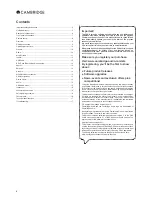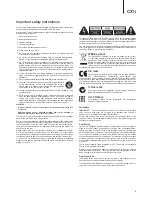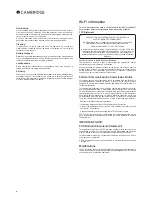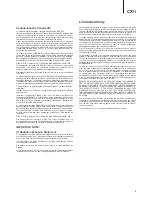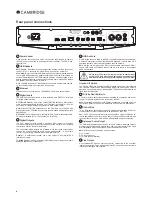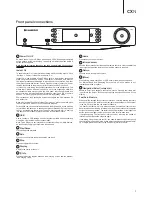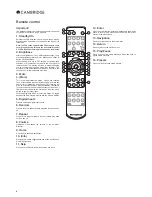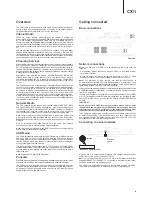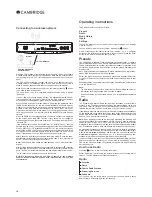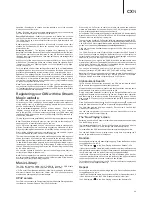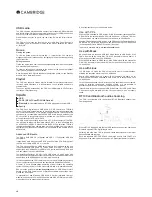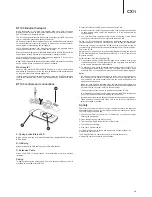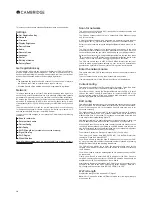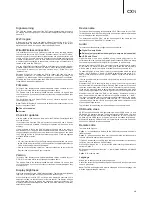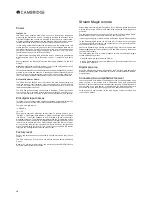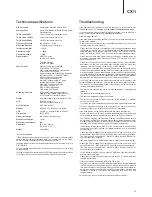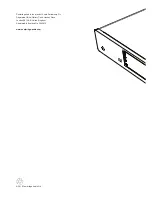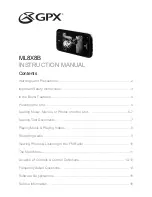
12
USB media
The CXN can also playback audio content from standard USB hard-drives
and thumb drives. Simply copy your media files onto your USB drive and then
connect it to the front or back USB sockets of the unit.
Press the Home button to get to the top menu. Select the 'Music Library'
menu.
The CXN will now scan the thumb drive for media files. Once the scan is
completed, you will then be able to browse the files by selecting 'By Album'
or 'By Artist'.
Queue
Viewing the queue
To view the queue at any time press the '•••' (more) button. You can jump
playback to any point in the queue by navigating up/down the list and pressing
the Enter button.
Editing the queue
Tracks can be removed from the queue by highlighting them with the navigator
and pressing the Stop button.
To clear an entire queue, navigate to the bottom of the queue to highlight
[Clear Queue] and press the Enter button.
Note: Switching the CXN into standby will delete the queue, unless Standby
Mode is set to 'Network Standby'.
Playlist
The CXN also supports various playlist formats. For permanent storage of
favourite media selections it is recommended to use suitable software to
create playlist.
These can then be accessed by the CXN from USB Media or UPnP servers
that support Playlist serving.
Inputs
»
USB
»
D1-D2 (S/PDIF Coax/TOSLINK Optical)
»
Bluetooth
(Only available when a BT100 is plugged into the rear USB)
»
Spotify
The CXN has 3 digital inputs, USB Audio, S/P DIF co-axial and TOSLINK
optical. The digital inputs allow you to play audio sent from a separate digital
audio source such as a PC or CD player with digital outputs. This can optimise
sound quality, for example where the CXN USB Audio is used instead of the
PC soundcard or the upsampled and re-clocked low jitter DACs of the CXN
are used instead of a CD player DACs.
The USB Audio input directly connects to a PC or Mac computer. The CXN
can be setup to stream via the simple setup USB1.1 or the high sample rate
24-bit/192kHz via USB2.0. Also note that the SP DIF co-axial and TOSLINK
inputs are capable of high sample rates up to 24-bit/192kHz, but your source
equipment and interconnect cables must be capable of this sample rate to
achieve this.
Advanced USB audio
The CXN is both USB 2.0 (Hi-Speed) and USB 1.1 (Full-speed) USB port
compatible.
It should also work with the new USB 3.0 ports where the PC will simply treat
the CXN as if it were a USB 2.0 or 1.1 device.
The CXN also supports two USB Audio protocols (not the same as the port
types themselves) USB Audio 1.0 (which works over USB 1.1 ports and
supports up to 24-bit/96kHz) or USB Audio 2.0 (which requires a USB 2.0 port
and can support up to 24-bit/192kHz).
The default configuration is USB 1.1 and USB Audio 1.0 which works with
nearly all common operating systems and computer types without drivers and
supports up to 24-bit/96kHz audio, simply plug in and play.
In this configuration the CXN is able to work at up to 24-bit/96kHz by declaring
to your computer that it can handle any sample rate from 32kHz to 96kHz.
However in some Windows/Mac operating system variants the operating
system itself may restrict or fix the output sample rate or re-sample the audio.
See our online guide at
www.cambridgeaudio.com
on USB Audio for more
details on this. With careful choice of playback software and settings many
pitfalls can be avoided.
In particular our free Windows USB Audio 2.0 driver (available from our
website) supports up to 24-bit/192kHz audio and WASAPI Exclusive or ASIO
modes that can give enhanced performance.
A brief explanation of your choices are below:
Use with PCs
With the CXN switched to USB Audio 1.0 (this is the default setting) the CXN
will work with the native Windows XP, Vista, Windows 7 or 8 Audio 1.0 driver
(no need to load any new driver) and accept audio up to 24-bit/96kHz.
With the CXN switched to USB Audio 2.0 the CXN needs the Cambridge Audio
USB Audio 2.0 Driver to be loaded and can then accept up to 24-bit/192kHz
(and support ASIO and WASAPI Exclusive if required).
The driver is available from
www.cambridgeaudio.com
.
Use with Macs
No extra drivers are required. With the CXN switched to USB Audio 1.0 the
CXN will work with the native Mac OS-X 10.5 (Leopard) or above Audio 1.0
driver and accept audio up to 24-bit/96kHz.
With the CXN switched to USB Audio 2.0 the CXN works with the native Mac
OS-X 10.5 (Leopard) or above Audio 2.0 driver and can accept audio up to
24-bit/192kHz.
Use with Linux
In USB Audio 1.0 mode the CXN will work with most Linux distributions,
allowing the playback of audio up to 24-bit/96kHz.
Newer Linux distributions (e.g. Ubuntu 10.04) support USB Audio 2.0 for
which the CXN should be switched to USB Audio 2.0 to accept audio up to
24-bit/192kHz.
For both cases because Linux distributions vary according to their creators'
choice of software components, including drivers, it is not possible to
guarantee operation and Audio drivers may need to be loaded.
‘Class drivers’ for generic support of USB Audio Class 1.0 or USB Audio Class
2.0 devices may be available from the Linux community, we do not supply
these.
BT100 and Bluetooth audio streaming
The CXN is compatible with the optional BT100 Bluetooth adaptor from
Cambridge Audio.
When a BT100 is plugged into the rear USB socket an extra menu item called
Bluetooth appears in the Digital Inputs menu.
Selecting this allows the CXN to receive wireless Bluetooth audio from most
phones/tablets and laptops.
Both the standard SBC CODEC and newer high quality aptX CODEC are
supported (if the sending device supports it). Contact your dealer for details.
Summary of Contents for CXN
Page 1: ...CXN NETWORK PLAYER ...


